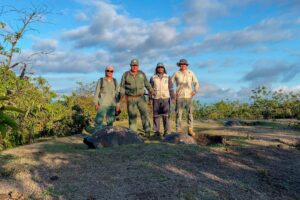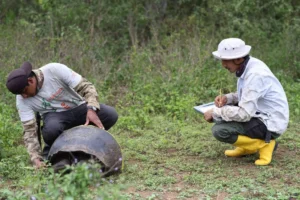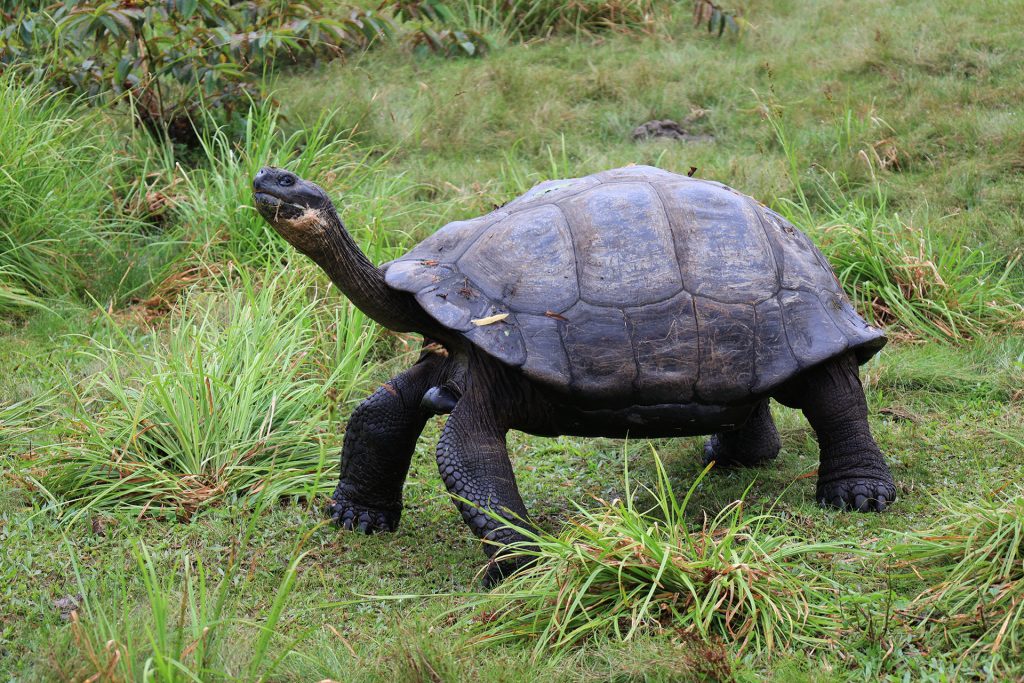We have reached a significant milestone in collaboration with the Galapagos National Park Directorate by conducting a comprehensive census of all nine populations, including Chelonoidis viscina, Chelonoidisguntheri, and HTML2_ Chelonoidis sp. HTML2_. This groundbreaking census thoroughly surveyed these populations, which reside in the southern volcanic areas of Isabela Island. It marks a significant accomplishment in our conservation efforts.
The Tortoise Tracking Project: A monumental task

©Galápagos Conservancy
A team of scientists and park rangers from the Galapagos Conservancy took on a massive task between January 2023 and December 2023. The team’s goal was to count the tortoises in the nine populations that live on the Sierra Negra volcano and Cerro Azul.
The terrain in these regions is rough and difficult to access. The team persevered in spite of harsh weather conditions such as intense sun or heavy rain. They have shed light on mysteries and challenges that these unique species face. Their efforts have yielded valuable scientific data vital for developing optimal conservation strategy.
Preliminary results after a year of expeditions
Scientist Jorge Carrion stated that the survey was the first ever complete count of tortoises conducted in the southern part of the archipelago. This monumental effort was made possible by passionate Galapagos conservationists. It provides updated and detailed insights into the conservation status for the tortoises of Southern Isabela and their ecosystems. He said that it was a “significant milestone”.
We have updated population data on two tortoise types following these expeditions. We carefully tracked and located a total number of 4,146 C. We located and carefully monitored a total of 4,146 C. guntheri tortoises. The morphometric measurements and the location of their tortoises were carefully documented in order to better understand their distribution. Our President, James Gibbs pointed out that the new findings have revised the estimate of C. Vicina on Cerro Azul Volcano to around 5,275 individuals, and 704 for Sierra Negra.
Scientist Washington Tapia is our General Director. He stated, “Following this rigorous scientific undertaking and the subsequent analysis of data, we now have not only updated information about population status and seasonal range, but also a thorough understanding of the challenges facing the two tortoise types inhabiting this region.” This information will allow us to make management recommendations and take specific actions in order to conserve the two tortoise species inhabiting this area.
Current Conservation Challenges

©Galápagos Conservancy
In Southern Isabela, our research team has identified threats to tortoises, particularly the newborns. C. Both C. Guntheri tortoises fight against invasive species. These reptiles are facing formidable threats from feral pigs, cattle, fire ants and rats. Feral pigs are a major threat, as they devour tortoise hatchlings and eggs. Washington Tapia said, “This is an urgent call to action, and we must intensify our efforts to protect these iconic species. The vulnerability of tortoises requires our immediate attention, and decisive actions.”
With our flagship program Iniciativa Galapagos developed in collaboration the Galapagos National Park Directorate we go beyond simple population counts. With the support of friends who are committed to conserving the unique biodiversity of the Galapagos Islands, we focus on restoring ecosystems by recovering ecologically important species such as the iconic giant turtles.
Conservation efforts by our organization for C. Vicina and C. Guntheri populations this year are testaments to the courage, resilience and commitment of our park rangers, as well as the scientists who have led the conservation efforts. Our donors’ generous contributions have been crucial in protecting and maintaining this important endeavor.
Galapagos giant turtles are essential to maintaining the balance of ecosystems. Galapagos Conservancy conducts scientific expeditions in order to manage the island’s population effectively. We are able to do our work because of the generous donations we receive from our supporters. With the support of our loyal supporters, we hope to continue to make significant contributions to conservation. Want to join us?



